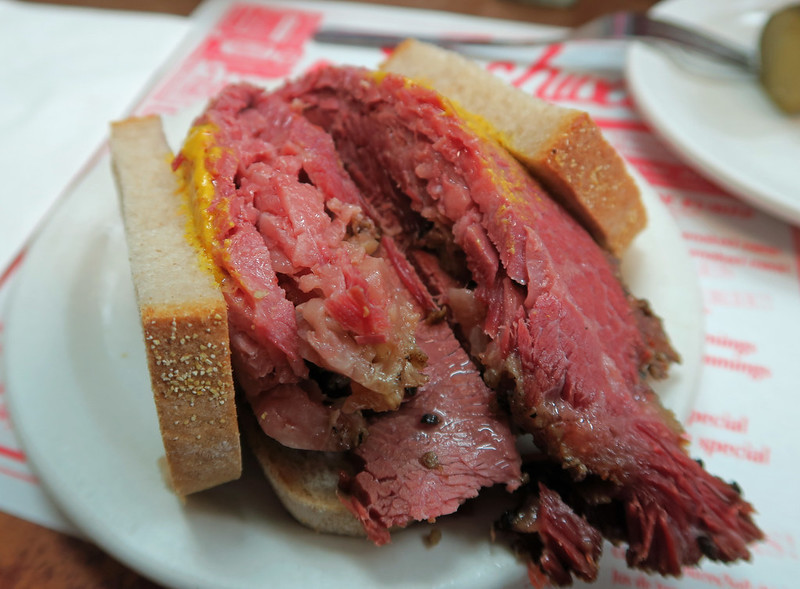The roots of the Jewish community in Canada go back to 1760 when Jews began to settle in Canada after the British Conquest of New France. The community remained small until the 1880s when large numbers of Ashkenazi Jews left Eastern Europe and made Canada their new home. The next major cohort of Jewish immigration began in the late 1950s when Jews from Morocco settled in Quebec. Each of these communities brought food from their homelands with them to Canada. They changed the food landscape of cities across the country. Many of these dishes remain an important part of Canada’s culinary identity to this day. (See Jewish Food in Canada.)
Blueberry Buns
Blueberry buns are a pastry that is unique to Toronto’s Jewish community. Also known by their Yiddish name, shtritzlach, they’re made with a sweet, yeasted dough that is filled with a runny blueberry filling made of fresh or already-cooked blueberries. The pastries are shaped into a half moon, glazed with an egg wash and topped with sugar before being baked. It is believed that Annie Zuckerman Kaplansky brought these pastries from Poland to Toronto in 1913. Later on, she sold them at her legendary, but now shuttered, Health Bread Bakery.
Challah
A tradition found in every Jewish community is to have loaves of bread for the Sabbath meal. They’re covered with a cloth to represent the manna, which was protected with a layer of dew while the ancient Israelites wandered the desert. Various Sabbath breads can be found in different Jewish communities. The most recognizable one in North America has become the Ashkenazi challah. It is a yeasted bread enriched with eggs, sugar and oil, which is braided and often topped with sesame seeds before baking.
For Jews in Eastern Europe, everyday bread was made with whole wheat flour, rye or other grains, while challah was the special loaf made with more expensive white flour. Traditionally shaped into a long braid, other shapes exist for different holidays. These include a circular challah for Rosh Hashanah or a key-shaped challah for the first Sabbath after Passover.

Cheese Bagels
Cheese bagels are mostly unknown outside of Montreal’s Jewish community. They are a horseshoe-shaped pastry in which a flaky dough is filled with a sweet farmer’s cheese filling. Depending on personal preferences, the bagel can be topped with coarse sugar crystals. Everything is then baked until golden brown.
Cheese bagels are often eaten with sour cream and jam as an after-school snack or as part of a brunch spread. This bagel’s origins are murky, but it is possible that it’s a cousin to the Danish or the knish ― two popular filled European pastries.

Chicken Soup
Affectionately known as Jewish Penicillin, chicken soup is a beloved dish within Jewish cuisine that evokes feelings of comfort and nostalgia. Part of Sephardic cuisine since at least the medieval period, it was served to the weak and sick, and at the pre-fast meal on Yom Kippur. Many variations exist: Yemenite Jews add hawaij spice mix to their chicken soup, Persian Jews add gundi (a cross between a dumpling and a meatball) while Greek Jews add lemon and egg to make avgolemono.
Chicken soup became a popular dish in the Ashkenazi community in the 15th century and has become one of the most well-known Jewish dishes in North America. It is usually served with noodles, mandlen (soup nuts), matzo balls or kreplach (filled dumpling) at Shabbat dinner and various other holiday meals.
Montreal Bagels
The origins of the bagel can be traced back to Poland via Germany, where non-Jewish bakers were making a ring-shaped bread that was boiled and then baked, called the obwarjanek. Jewish bakers in Poland made a similar bread called beigel or bajgele in Polish. As the number of Jewish bakers in the country grew, this bread would have more often been referred to as a bagel, coming from the Yiddish word beigen, meaning “to bend.”
Bagels are made with a yeasted dough that is shaped into a ring, boiled then baked. Montreal bagels are unique in their preparation. They’re shaped by hand and boiled in honey water: this lends a sweetness and helps to create that signature crispy crust. Finally, the bagels are baked in a wood-fired oven.
The first bagel bakery in Montreal was located on Boulevard Saint-Laurent. (See also Iconic Streets in Canada.) Two of the partners who ran this first shop were Isadore Shlafman and Hyman Seligman. In 1949, they went on to open a bagel bakery in the location where Fairmount bagel is located today. Hyman Seligman left this shop in the early 1950s to open St-Viateur Bagel while the Shlafman family continues to run Fairmount bagel. Each helped to shape Montreal’s bagel culture into what it is today.
More than just a dish eaten by the Jewish community, the bagel has become an icon of Montreal.
Montreal-Style Smoked Meat
A smoked meat sandwich is a must-have when visiting Montreal. The smoked meat we know today comes from a Turkish dish called basturma ― a dish of pressed and cured meat. The Ottoman Turks introduced basturma to Romania, where it was then adopted by Romanian Jews and called pastrama. As artificial refrigeration became available, the dish made of softer smoked meat we know today emerged. Romanian Jews who settled in Montreal brought this dish to the city.
Smoked meat is made from beef brisket. The meat is cured for 10 to 12 days in a mix of spices that include salt, coriander, black pepper, garlic, red pepper flakes, mustard seeds, garlic and celery seeds. The briskets are then smoked for eight to nine hours and steamed for about three hours. After being thinly sliced, they’re stacked between slices of rye bread and served with mustard, creating an outstanding sandwich. The classic Montreal order at one of the city’s delicatessens is a smoked meat sandwich, French fries and a Cott black cherry soda.

Salade Cuite
Jews from Morocco began to settle in Montreal in the late 1950s. (See also Côte-des-Neiges.) Today, they’re an important part of the city’s Jewish community. Salade cuite is a popular slow-cooked dip that can be found on Jewish Moroccan tables across the city. The recipe is made of chopped tomatoes, roasted red and green bell peppers, garlic, paprika and olive oil. Everything is then cooked until the dish is thick and jammy. Salade cuite, also known as matbucha, which means “cooked stuff,” is a salad that is made ahead of time and eaten at room temperature. Due to this, it is traditionally served at Shabbat dinner, along with a variety of other salads, to begin the meal.

Shmoo Torte
The Schmoo Torte is a popular dessert found in bakeries across Winnipeg. Legend says that a mother invented it for her son’s bar mitzvah. It is made of layers of pecan angel food cake that is coated with whipped cream and drizzled with caramel. This dessert finds its origins in the nusstorte, meaning “nut cake,” of Germany, Hungary and Austria. These cakes were typically made by mixing ground walnuts or hazelnuts with whipped egg whites, egg yolks, and, sometimes, flour. Central European and other Ashkenazi Jews began making them for Passover in their flourless form. For other special occasions throughout the year, the cakes are topped with whipped cream.

 Share on Facebook
Share on Facebook Share on X
Share on X Share by Email
Share by Email Share on Google Classroom
Share on Google Classroom



